Abstract
The nature of the inhibitory neurotransmitter responsible for internal anal sphincter (IAS) relaxation in response to rectoanal reflex is not known. The objective of the present investigation was to examine the role of VIP in IAS relaxation in response to the rectoanal reflex in intact opossums with the use of VIP antagonists, [4CI-D-Phe6,Leu17] VIP and (N-AC-Tyr1,D-Phe2)-GRF (1-29)-NH2. Intraluminal pressures from the sphincter were monitored using low-compliance, continuously perfused catheters. VIP and the antagonists were administered close-intraarterially. The responses to VIP, rectoanal reflex, sacral nerve stimulation, and local intramural stimulation were examined before and after the VIP antagonists. The present studies in intact animals show: (a) VIP causes a dose-dependent fall in the IAS pressures by a direct action at the IAS smooth muscle; (b) VIP antagonists selectively and significantly antagonized the inhibitory action of VIP; and (c) VIP antagonists caused significant antagonism of the IAS relaxation caused by rectoanal reflex and the other neural stimuli. The antagonism of the IAS relaxation by the VIP antagonists, depending upon the volume of rectal distension used, ranged from 40% to 62% (P less than 0.05). From these results, we conclude that VIP acts as an inhibitory neurotransmitter for IAS relaxation during the rectoanal reflex.
Full text
PDF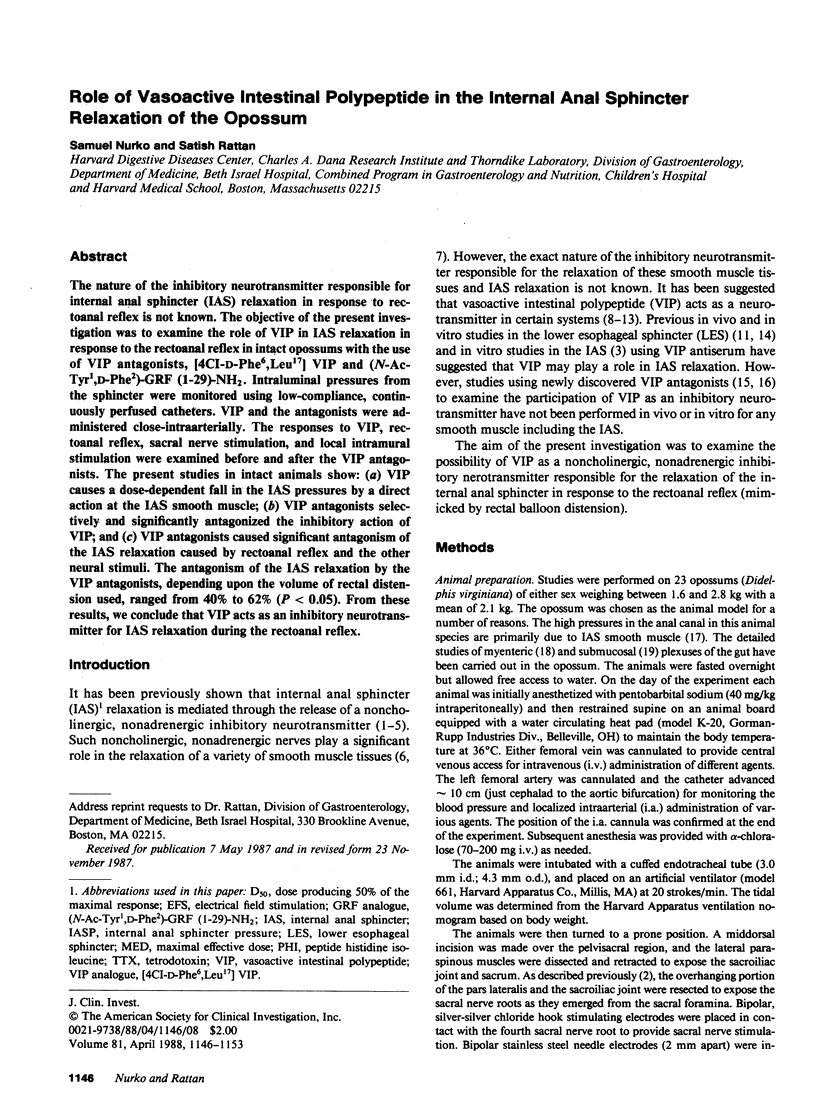
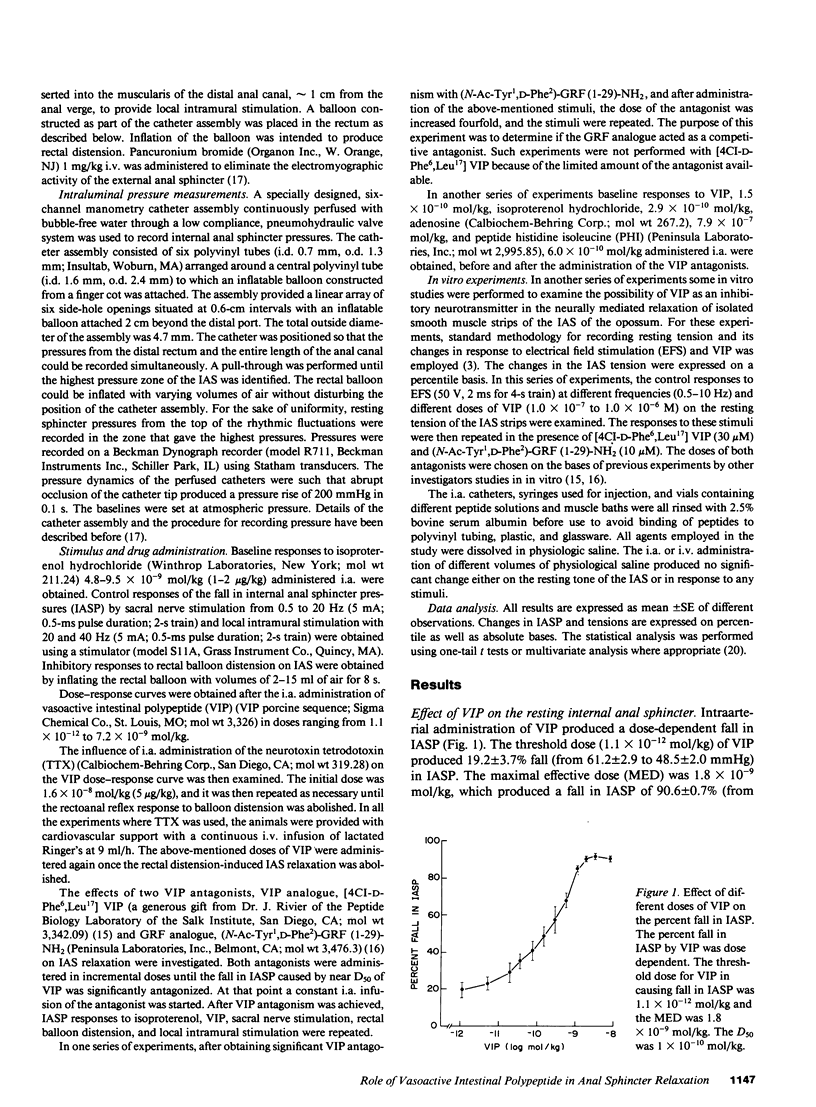
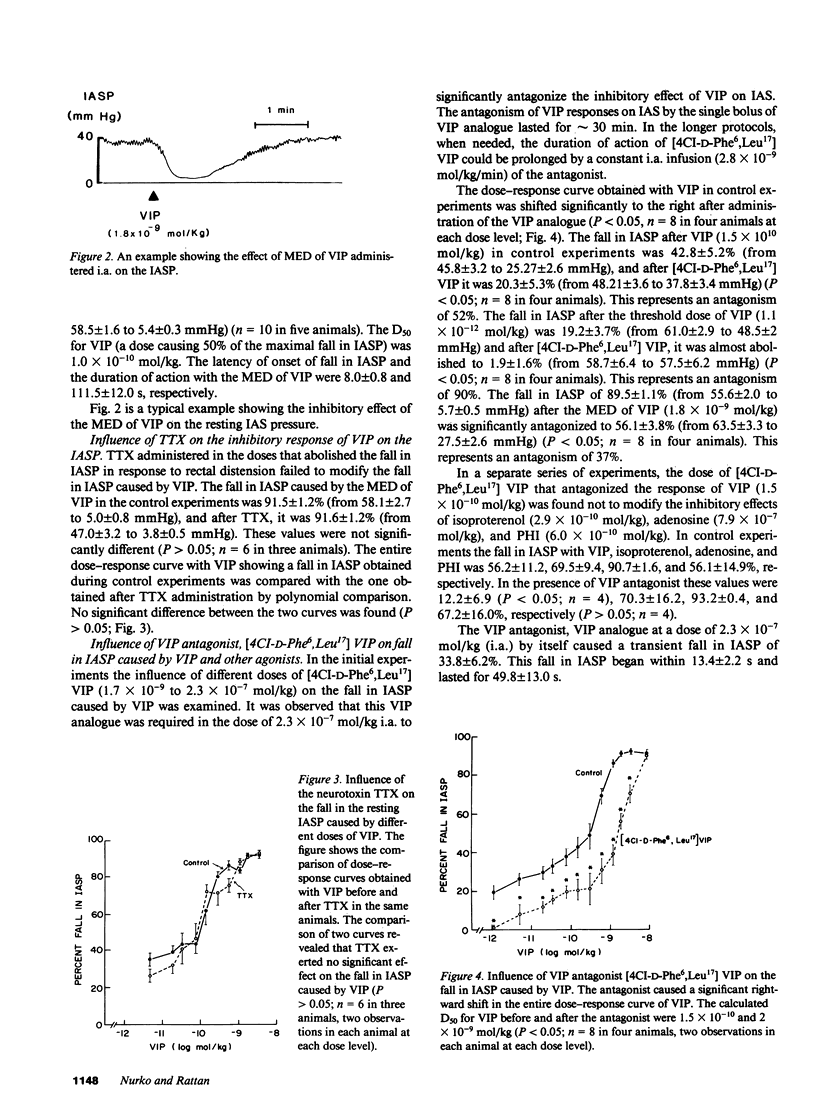
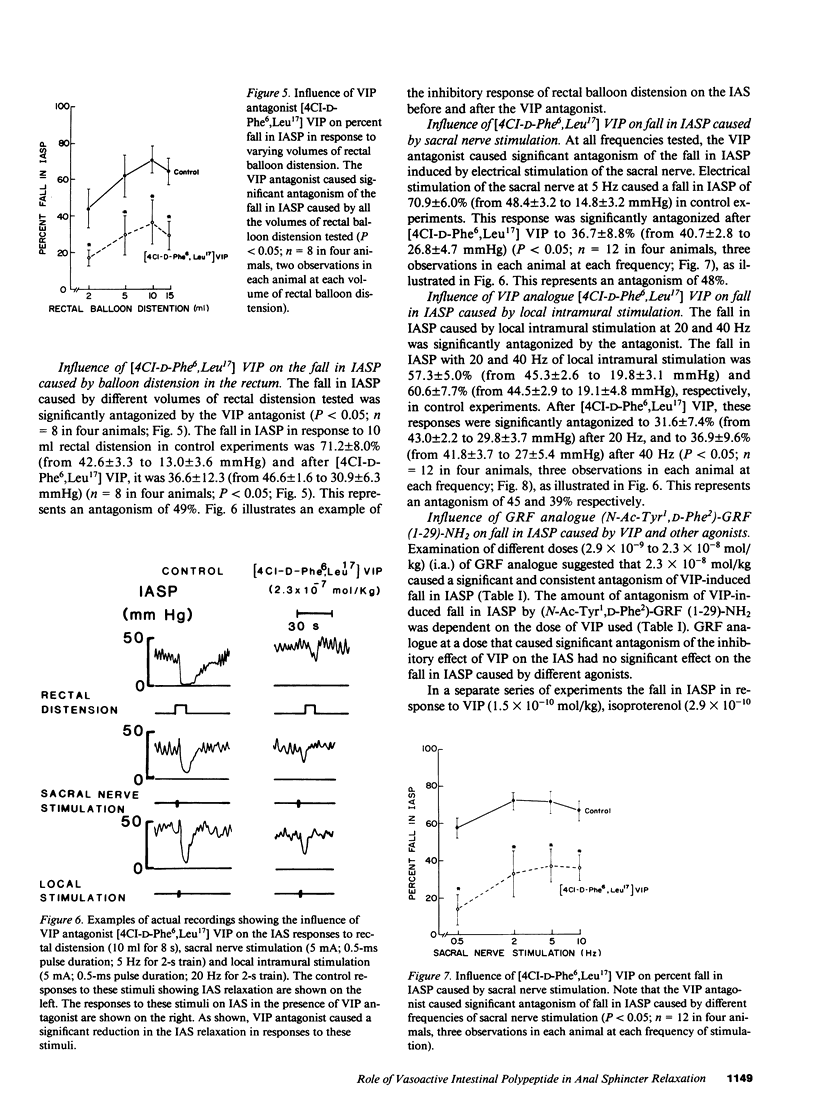

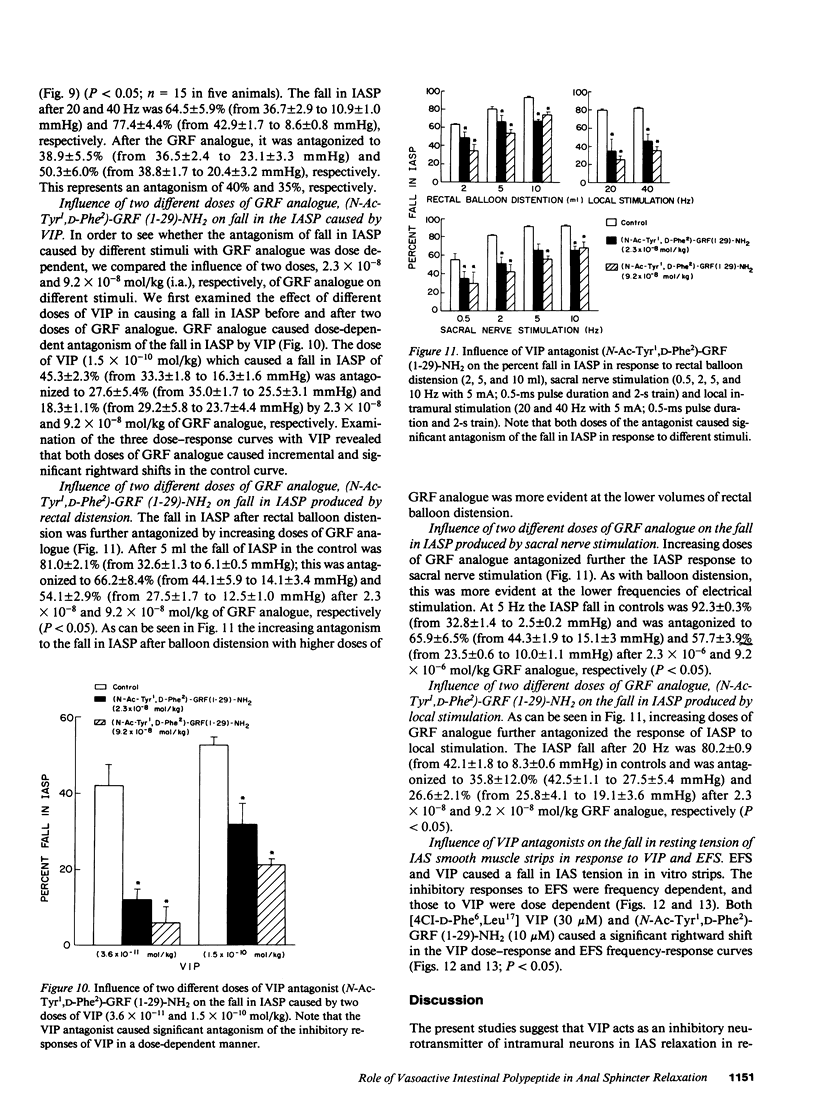
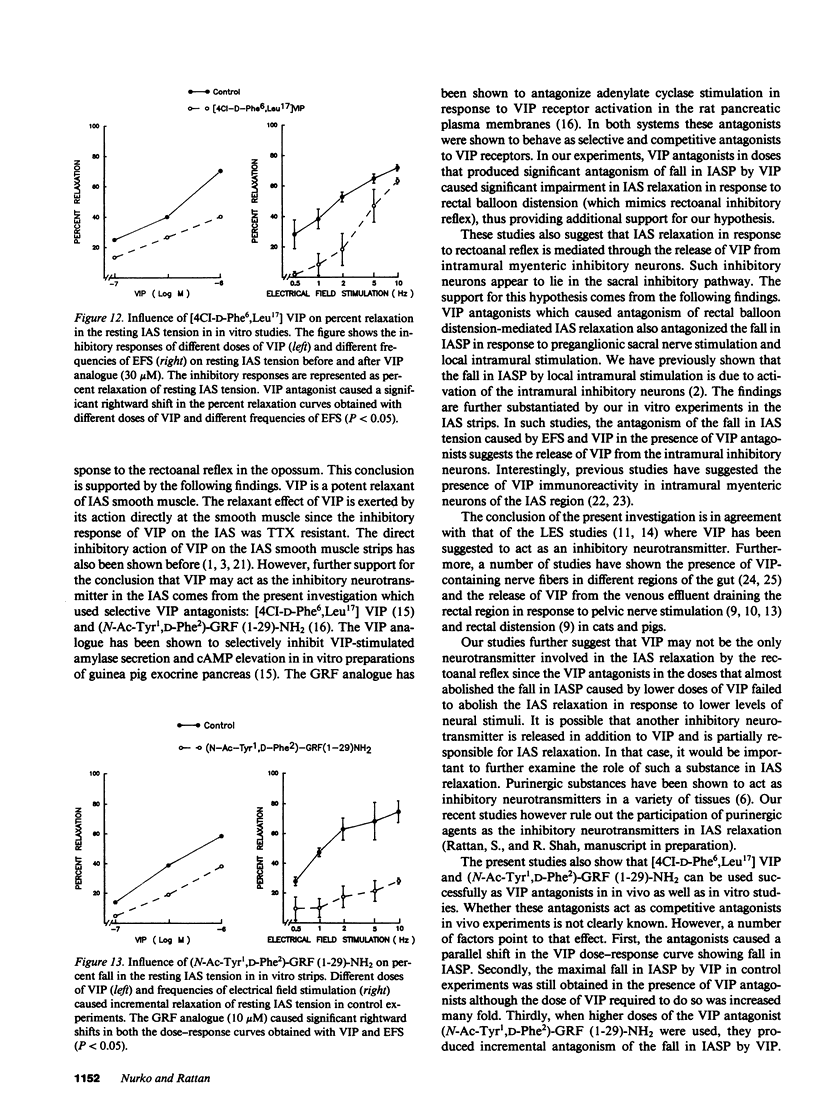
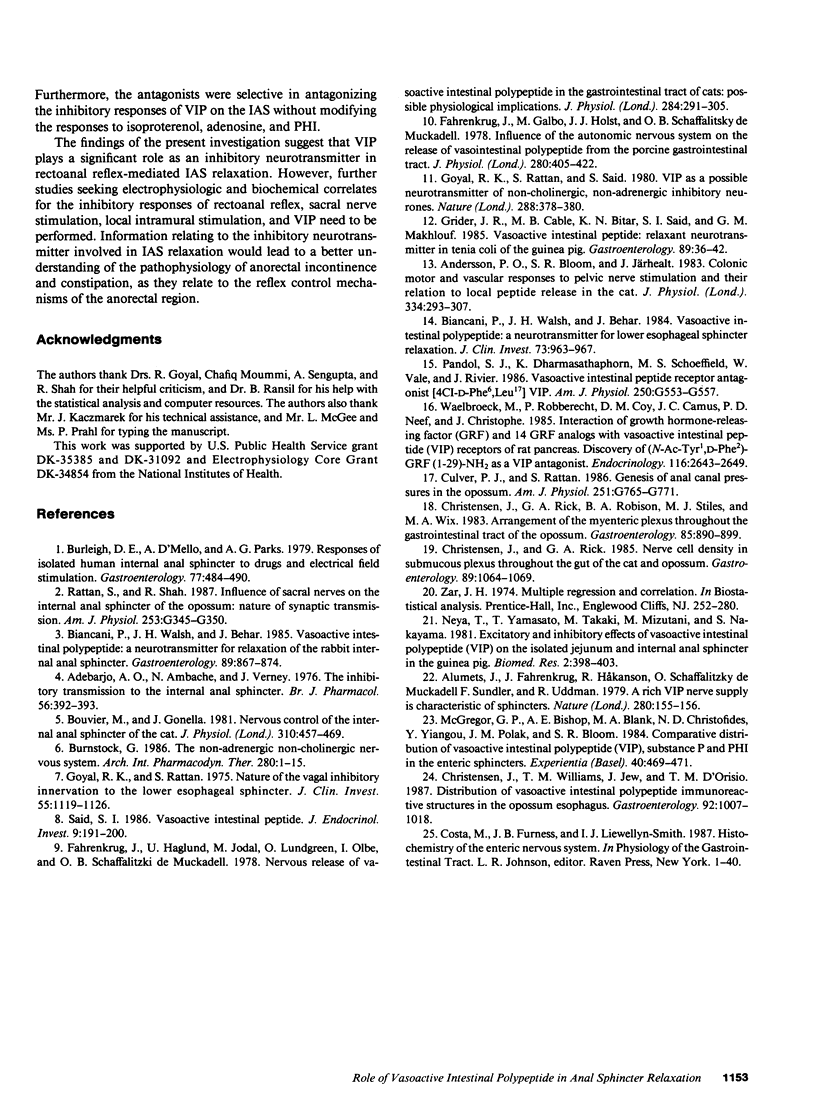
Selected References
These references are in PubMed. This may not be the complete list of references from this article.
- Alumets J., Schaffalitzky de Muckadell O., Fahrenkrug J., Sundler F., Håkanson R., Uddman R. A rich VIP nerve supply is characteristic of sphincters. Nature. 1979 Jul 12;280(5718):155–156. doi: 10.1038/280155a0. [DOI] [PubMed] [Google Scholar]
- Andersson P. O., Bloom S. R., Järhult J. Colonic motor and vascular responses to pelvic nerve stimulation and their relation to local peptide release in the cat. J Physiol. 1983 Jan;334:293–307. doi: 10.1113/jphysiol.1983.sp014495. [DOI] [PMC free article] [PubMed] [Google Scholar]
- Biancani P., Walsh J. H., Behar J. Vasoactive intestinal polypeptide. A neurotransmitter for lower esophageal sphincter relaxation. J Clin Invest. 1984 Apr;73(4):963–967. doi: 10.1172/JCI111320. [DOI] [PMC free article] [PubMed] [Google Scholar]
- Biancani P., Walsh J., Behar J. Vasoactive intestinal peptide: a neurotransmitter for relaxation of the rabbit internal anal sphincter. Gastroenterology. 1985 Oct;89(4):867–874. doi: 10.1016/0016-5085(85)90585-2. [DOI] [PubMed] [Google Scholar]
- Bouvier M., Gonella J. Nervous control of the internal anal sphincter of the cat. J Physiol. 1981 Jan;310:457–469. doi: 10.1113/jphysiol.1981.sp013561. [DOI] [PMC free article] [PubMed] [Google Scholar]
- Burleigh D. E., D'Mello A., Parks A. G. Responses of isolated human internal anal sphincter to drugs and electrical field stimulation. Gastroenterology. 1979 Sep;77(3):484–490. [PubMed] [Google Scholar]
- Burnstock G. The non-adrenergic non-cholinergic nervous system. Arch Int Pharmacodyn Ther. 1986 Apr;280(2 Suppl):1–15. [PubMed] [Google Scholar]
- Christensen J., Rick G. A. Nerve cell density in submucous plexus throughout the gut of cat and opossum. Gastroenterology. 1985 Nov;89(5):1064–1069. doi: 10.1016/0016-5085(85)90210-0. [DOI] [PubMed] [Google Scholar]
- Christensen J., Rick G. A., Robison B. A., Stiles M. J., Wix M. A. Arrangement of the myenteric plexus throughout the gastrointestinal tract of the opossum. Gastroenterology. 1983 Oct;85(4):890–899. [PubMed] [Google Scholar]
- Christensen J., Williams T. H., Jew J., O'Dorisio T. M. Distribution of vasoactive intestinal polypeptide-immunoreactive structures in the opossum esophagus. Gastroenterology. 1987 Apr;92(4):1007–1018. doi: 10.1016/0016-5085(87)90977-2. [DOI] [PubMed] [Google Scholar]
- Culver P. J., Rattan S. Genesis of anal canal pressures in the opossum. Am J Physiol. 1986 Dec;251(6 Pt 1):G765–G771. doi: 10.1152/ajpgi.1986.251.6.G765. [DOI] [PubMed] [Google Scholar]
- Fahrenkrug J., Galbo H., Holst J. J., Schaffalitzky de Muckadell O. B. Influence of the autonomic nervous system on the release of vasoactive intestinal polypeptide from the porcine gastrointestinal tract. J Physiol. 1978 Jul;280:405–422. doi: 10.1113/jphysiol.1978.sp012391. [DOI] [PMC free article] [PubMed] [Google Scholar]
- Fahrenkrug J., Haglund U., Jodal M., Lundgren O., Olbe L., de Muckadell O. B. Nervous release of vasoactive intestinal polypeptide in the gastrointestinal tract of cats: possible physiological implications. J Physiol. 1978 Nov;284:291–305. doi: 10.1113/jphysiol.1978.sp012541. [DOI] [PMC free article] [PubMed] [Google Scholar]
- Goyal R. K., Rattan S. Nature of the vagal inhibitory innervation to the lower esophageal sphincter. J Clin Invest. 1975 May;55(5):1119–1126. doi: 10.1172/JCI108013. [DOI] [PMC free article] [PubMed] [Google Scholar]
- Goyal R. K., Rattan S., Said S. I. VIP as a possible neurotransmitter of non-cholinergic non-adrenergic inhibitory neurones. Nature. 1980 Nov 27;288(5789):378–380. doi: 10.1038/288378a0. [DOI] [PubMed] [Google Scholar]
- Grider J. R., Cable M. B., Bitar K. N., Said S. I., Makhlouf G. M. Vasoactive intestinal peptide. Relaxant neurotransmitter in tenia coli of the guinea pig. Gastroenterology. 1985 Jul;89(1):36–42. [PubMed] [Google Scholar]
- McGregor G. P., Bishop A. E., Blank M. A., Christofides N. D., Yiangou Y., Polak J. M., Bloom S. R. Comparative distribution of vasoactive intestinal polypeptide (VIP), substance P and PHI in the enteric sphincters of the cat. Experientia. 1984 May 15;40(5):469–471. doi: 10.1007/BF01952390. [DOI] [PubMed] [Google Scholar]
- Pandol S. J., Dharmsathaphorn K., Schoeffield M. S., Vale W., Rivier J. Vasoactive intestinal peptide receptor antagonist [4Cl-D-Phe6, Leu17] VIP. Am J Physiol. 1986 Apr;250(4 Pt 1):G553–G557. doi: 10.1152/ajpgi.1986.250.4.G553. [DOI] [PubMed] [Google Scholar]
- Rattan S., Shah R. Influence of sacral nerves on the internal anal sphincter of the opossum. Am J Physiol. 1987 Sep;253(3 Pt 1):G345–G350. doi: 10.1152/ajpgi.1987.253.3.G345. [DOI] [PubMed] [Google Scholar]
- Said S. I. Vasoactive intestinal peptide. J Endocrinol Invest. 1986 Apr;9(2):191–200. doi: 10.1007/BF03348097. [DOI] [PubMed] [Google Scholar]
- Waelbroeck M., Robberecht P., Coy D. H., Camus J. C., De Neef P., Christophe J. Interaction of growth hormone-releasing factor (GRF) and 14 GRF analogs with vasoactive intestinal peptide (VIP) receptors of rat pancreas. Discovery of (N-Ac-Tyr1,D-Phe2)-GRF(1-29)-NH2 as a VIP antagonist. Endocrinology. 1985 Jun;116(6):2643–2649. doi: 10.1210/endo-116-6-2643. [DOI] [PubMed] [Google Scholar]


